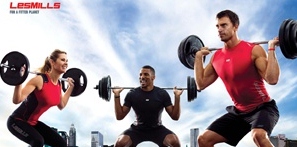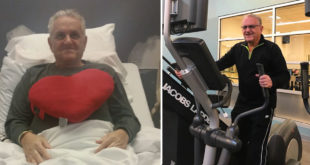by Michelle Sutton-Kerchner
Life’s filled with enough figurative headaches without suffering from the kind that actually throb in your head. Learn how to soothe away this common nuisance …
Millions are affected by head pain each day. Whether chronic or occasional, we all suffer from headaches at some time. Tension, migraine, sinus. They could be triggered by stress, weather, food, or something as simple as not enough sleep. This results in abundant use of over-the-counter painkillers, each brand arguing to be your one-pill remedy.
Before you pop your next ibuprofen, consider a dose of preventative medicine: exercise. Take advantage of a good workout’s natural chemical release to block pain signals to the brain. It is often recommended as part of a comprehensive treatment program for headaches and chronic pain conditions.
Tension Headaches
Approximately 90 percent of all headaches are induced by tension. Whether you feel a vice-like grip around your head or notice a dull ache behind your eyes, it often signals a tension headache. With the hustle common during the upcoming holidays, no need to brace yourself. In fact, that’ll probably bring on a headache. Instead, prevent tension headaches, and muscle aches in general, with a regular exercise regimen.

Choose an activity you truly enjoy for the ultimate effect. For example, don’t drudgingly lift weights when you’d rather be socializing. A headache in itself. Instead, take a Body Pump class that incorporates weightlifting in a fun, group setting. You double the pleasure principle: exercise and another gratifying activity, both of which relieve stress. Done at approximately the same time each day, your body syncs into a natural rhythm for tension release.
Elevate your heart rate for at least twenty minutes on most days. This increases blood flow and decreases blood pressure, a great long-term remedy in keeping away headaches.
Sinus Headaches
Research shows aerobic exercise at least four times a week helps naturally drain sinuses. Unclogged sinuses reduce the likelihood of sinus headaches and facial pain brought on by inflammation and infection. Those who suffer allergies may experience frequent sinus headaches that may be preventable by an ongoing fitness routine. (For more on how exercise helps reduce allergy symptoms, see “Exercise Control of Your Allergies,” F&W News, April 6, 2011, www.fitnessandwellnessnews.com/health/exercise-control-of-your-allergies/).
 Remain hydrated, especially during a sweat session. A vigorous workout results in significant fluid loss. If you’re taking a decongestant or other allergy medication, you may also suffer from dry mouth. In addition to sipping water throughout, two to three cups of water are recommended pre- and post-workout.
Remain hydrated, especially during a sweat session. A vigorous workout results in significant fluid loss. If you’re taking a decongestant or other allergy medication, you may also suffer from dry mouth. In addition to sipping water throughout, two to three cups of water are recommended pre- and post-workout.
Experts also suggest starting each day with a large glass of water, regardless of activities planned for that day. Headaches are one of the primary symptoms of dehydration. When you feel one start, try a full glass of water before swallowing that Tylenol.
Hormonal Headaches
Men and women both suffer from headaches prompted by hormonal shifts. Fluctuations that occur around menstruation can trigger severe and predictable headaches on certain days of the month. Rather than black out those days on the calendar every month, try avoiding the headaches. Increase feel-good hormones, like serotonin, through regular exercise. When that monthly headache looks to pay a visit, a boost of happy hormones will send it on its way.
Migraines
Studies have proven regular aerobic exercise can reduce the intensity and frequency of migraine headaches. One study followed participants enrolled in a cycling program. Sessions, which included a 15-minute warm-up, 20-minute cycle routine, and 5-minute cool-down, over a 12-week period (3 times weekly) resulted in a 28 percent reduction in migraine frequency. Headache severity was reduced by 18 percent and medication use by 24 percent. Cycling, anyone?
Use Yoga

There are many yoga poses that alleviate headaches, especially those caused by sinus pressure and tension. Asanas such as child pose, frog pose, downward-facing dog, and chair pose all work to increase the circulation of blood and oxygen. Consider joining a yoga class for ongoing prevention. Participation also allows familiarity with poses and breathing techniques. These can be used as needed to reduce physical and emotional negativity throughout your day.
Research proves adding approximately 15 minutes of relaxation training at the end of your fitness program provides additional headache relief. Close your routine with yoga or another form of exercise that emphasizes the mind-body connection. Incorporate this 15-minute relaxation respite even on days you don’t perform a full aerobic workout. Let the tension leave your body. Envision it exiting through your extremities.
Implement Daily Stretches
Gentle stretches can prevent the onset of headaches. They also may relieve ones that started in a morning meeting that ran through lunch (along with a sandwich, of course). Ask a personal trainer for specific movements to help reduce head pain. Here are some favorites:
Neck stretches, not neck rolls: Avoid rolling your neck in full circles. This continuous shift can be problematic to neck muscles. Instead, tilt head back as far as it comfortably goes. (Check out the ceiling paint.) Then, touch chin to chest. (Note any impressive ab work.) Look side to side, aligning your chin with shoulders. Repeat eight times, holding for five seconds each.
Head lifts: Decompress the neck area. Lace your fingers together and place linked hands at the base of your head at the back of your neck. Pull elbows forward and upward to gently lift your head slightly from your neck.
Remember to avoid stretching cold muscles, such as those stiff from frigid temps. Try using a heating pad on your neck or painful area prior to stretching for best results. If a stretch session made you sore, apply ice.
Don’t Be Counterproductive
Before jumping into a vigorous cardio workout, spend extra time warming up. A rapid shift in heart rate can trigger a headache. Spend about 20 minutes warming up each section of the body. Then, stretch. Tight muscles worked out when cold lead to tension and stiffness, a major cause of headaches.
Avoid abrupt changes. Gradually shift intensities throughout your workout. If you’re new to exercise, start slowly. Introducing intense fitness sessions during an overzealous health initiative phase (translate: unrealistic start-up) may also bring on headaches.
If your headache increases in intensity, moderate your workout or slowly stop the session. Exercise is not a cure-all for head pain. If you suffer chronic headaches, see your physician for a complete treatment plan. A personal trainer can work to adjust your routine based on your specific needs on any given day, pain-free or otherwise.
Alternative Therapies
Don’t underestimate the power to heal yourself.
If you feel a headache start, give yourself a quick massage. Rub the back of your neck, scalp, face, and shoulders. Use a few drops of peppermint or lavender oil, both of which have aromatherapeutic benefits.
Alternate the use of hot and cold packs on your head and neck. The shift in temperatures aids circulation around the area.
Herbal teas have a calming effect. A strong cup of hot caffeinated coffee may help relieve sinus headaches; the caffeine also may reduce migraine pain. However, be cautious of caffeine intake. In some instances, it can intensify headaches. When a headache strikes avoid icy cold drinks, ice cream, and sodium. All of these exacerbate head pain.

Walking and swimming are considered two of the best exercises in headache prevention. Incorporate aerobic activity into your daily routine.
We cannot eliminate most of life’s daily headache triggers. However, we can take proactive measures to reduce their frequency and severity. Wrap your head around exercises’ many benefits and feel the relief.
Sources
“Exercise and Headaches,” at www.nationalpainfoundation.org.
“How to Prevent a Sinus Headache,” at www.eHow.com.
“How to Treat a Headache Naturally,” at www.eHow.com.
“How to Use Exercise to Prevent Headaches,” at www.eHow.com.
“Tension-Type Headaches: Self-Care Measures for Relief,” at www.mayoclinic.com.
Image Credits
Head pain (introductory photo): www.flickr.com/photos/democlez/4463850560/
Lemon Water: © Kornwa at www.dreamstime.com.
Swim: www.flickr.com/photos/gcwest/136945653/
 Fitness & Wellness News Your Source for Fitness News, Wellness News, Health News, and Nutrition News!
Fitness & Wellness News Your Source for Fitness News, Wellness News, Health News, and Nutrition News!



